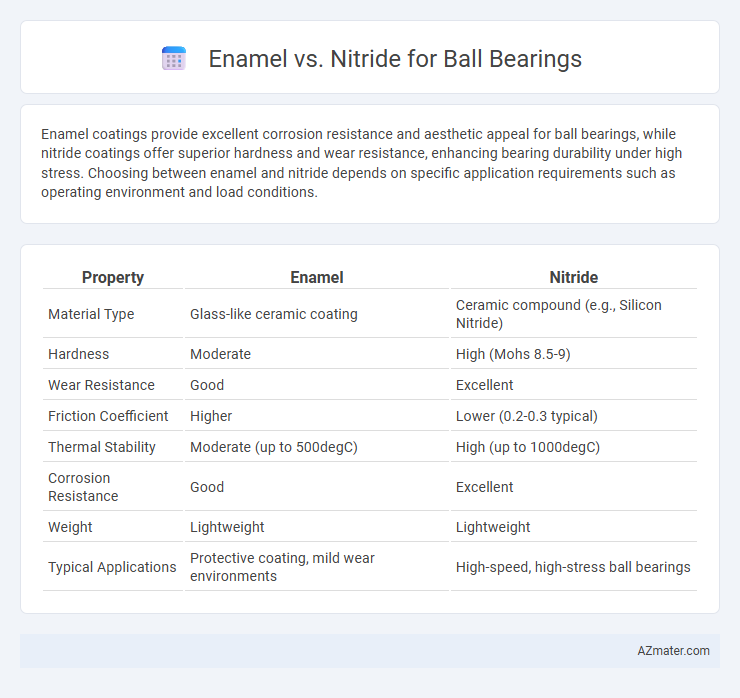Enamel coatings provide excellent corrosion resistance and aesthetic appeal for ball bearings, while nitride coatings offer superior hardness and wear resistance, enhancing bearing durability under high stress. Choosing between enamel and nitride depends on specific application requirements such as operating environment and load conditions.
Table of Comparison
| Property | Enamel | Nitride |
|---|---|---|
| Material Type | Glass-like ceramic coating | Ceramic compound (e.g., Silicon Nitride) |
| Hardness | Moderate | High (Mohs 8.5-9) |
| Wear Resistance | Good | Excellent |
| Friction Coefficient | Higher | Lower (0.2-0.3 typical) |
| Thermal Stability | Moderate (up to 500degC) | High (up to 1000degC) |
| Corrosion Resistance | Good | Excellent |
| Weight | Lightweight | Lightweight |
| Typical Applications | Protective coating, mild wear environments | High-speed, high-stress ball bearings |
Introduction to Ball Bearing Coatings
Ball bearing coatings significantly enhance durability, friction reduction, and wear resistance in mechanical applications. Enamel coatings provide excellent corrosion resistance and electrical insulation, ideal for harsh environments, while nitride coatings, such as titanium or chromium nitride, offer superior hardness and abrasion resistance. Selecting between enamel and nitride coatings depends on operational demands including load, speed, and environmental exposure to optimize bearing performance and service life.
Understanding Enamel Coatings
Enamel coatings on ball bearings provide excellent corrosion resistance and electrical insulation, enhancing durability in harsh environments. These coatings consist of glass-like materials fused onto the bearing surface, creating a smooth, wear-resistant layer that reduces friction and extends service life. Compared to nitride coatings, enamel offers superior chemical stability and protection against moisture, making it ideal for applications requiring both mechanical strength and environmental resilience.
Overview of Nitride Coatings
Nitride coatings on ball bearings provide superior hardness and wear resistance compared to traditional enamel coatings, enhancing bearing durability under heavy loads and high-speed conditions. These coatings improve corrosion resistance and reduce friction, resulting in smoother operation and extended service life. Common nitride compounds used include titanium nitride (TiN) and chromium nitride (CrN), which create a hard, thin protective layer that maintains dimensional stability and reduces maintenance requirements.
Key Differences Between Enamel and Nitride
Enamel coatings on ball bearings provide excellent corrosion resistance and electrical insulation but offer limited hardness compared to nitride treatments. Nitride coatings, such as titanium nitride or silicon nitride, significantly enhance surface hardness, wear resistance, and fatigue life, making them ideal for high-load and high-speed applications. While enamel focuses mainly on protecting against chemical damage, nitride treatments improve mechanical performance and durability under extreme operating conditions.
Durability: Enamel vs Nitride
Nitride coatings offer superior durability compared to enamel due to their enhanced hardness and wear resistance, which significantly reduce surface degradation in ball bearings. Enamel, while providing good corrosion resistance, tends to chip or crack under high stress and repeated friction, limiting its lifespan. Nitride's ability to maintain integrity under extreme operating conditions makes it the preferred choice for extending ball bearing durability.
Corrosion Resistance Comparison
Enamel coatings on ball bearings provide moderate corrosion resistance by forming a protective glass-like layer that prevents moisture and contaminants from reaching the metal surface. Nitride coatings, particularly through processes like plasma nitriding, offer superior corrosion resistance by creating a hard, dense, and wear-resistant surface layer that significantly reduces oxidation and rust formation. Comparing the two, nitride treatments generally outperform enamel in harsh environments due to their enhanced durability and long-term corrosion protection.
Performance in High-Temperature Environments
Enamel coatings on ball bearings offer excellent resistance to corrosion but degrade faster under high-temperature conditions, leading to reduced durability. Nitride coatings provide superior thermal stability and maintain hardness at elevated temperatures, making them ideal for high-performance applications in harsh thermal environments. Bearings with nitride treatment consistently exhibit enhanced wear resistance and longer service life when exposed to temperatures exceeding 300degC.
Cost Implications of Enamel and Nitride
Enamel coatings on ball bearings typically offer a lower initial cost due to simpler application processes and readily available materials, making them economically attractive for general-purpose uses. Nitride coatings, while more expensive upfront because of advanced deposition techniques such as gas nitriding or plasma nitriding, provide superior hardness and wear resistance, leading to extended bearing life and reduced maintenance costs over time. The higher durability of nitride coatings often translates into better long-term cost efficiency despite greater initial investment.
Application Suitability: Which to Choose?
Enamel coatings on ball bearings provide excellent corrosion resistance and aesthetic appeal, making them ideal for applications in harsh environments such as marine or chemical industries. Nitride coatings, known for their exceptional hardness and wear resistance, are better suited for high-load, high-speed machinery including automotive and aerospace components. Selecting between enamel and nitride depends on specific operational demands, with enamel preferred for corrosion protection and nitride chosen for durability under extreme mechanical stress.
Conclusion: Enamel or Nitride for Ball Bearings
Nitride coatings offer superior hardness, wear resistance, and corrosion protection for ball bearings, making them ideal in high-stress or corrosive environments. Enamel coatings provide adequate protection with lower cost but lack the durability and performance of nitrides under extreme conditions. Choosing nitride over enamel ensures enhanced bearing longevity and reliability in demanding applications.

Infographic: Enamel vs Nitride for Ball Bearing
 azmater.com
azmater.com